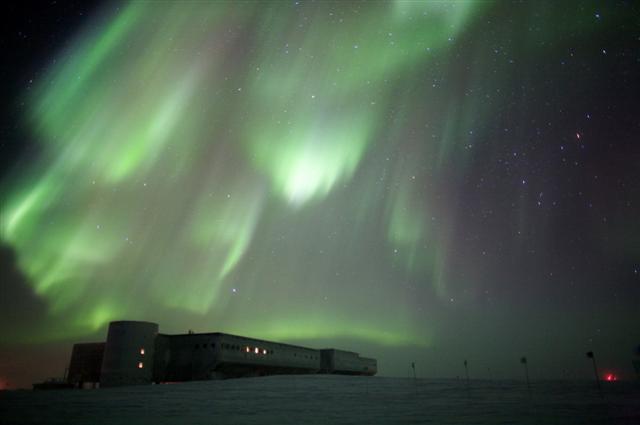Page 3/3 - Posted October 2, 2009
Lurking in the backgroundThe CMB is the relic afterglow of the Big Bang. When the universe was about 380,000 years old, it had cooled enough for matter and radiation to decouple and go their separate ways. That relic radiation survives today, pervading our daily existence. In the pre-digital era, about one percent of the static on “blank” TV channels consisted of this echo from the Big Bang. The cosmologist’s job, in effect, is to sort through all the ambient static in the universe and isolate the CMB signal — and the South Pole is the best place on Earth to do just that. Submillimeter, or microwave, radiation operates at a wavelength that happens to be particularly sensitive to water vapor. For the microwave astronomer, that sensitivity results in two distinct, equally complicating, problems. First, even small amounts of atmospheric moisture can absorb incoming millimeter-wavelength CMB signals, meaning that those photons never even reach the telescope. Second, that same water vapor can emit its own millimeter-wavelength signals — photons at the same wavelength as the CMB — meaning that astronomers can find themselves mistaking humidity for history. The Pole environment, fortunately, compensates for these potential problems. It’s high — more than 9,000 feet above sea level, so the atmosphere is thin. It’s dry — because the cold temperatures keep the amount of water vapor low. And during the austral winter, the atmosphere at the Pole is extremely stable, due to the absence of the heating and cooling effects of a rising and setting sun. Because the CMB preserves the image of the universe in its infancy, scientists think of it as cosmic DNA. The grown-up universe now is identical genetically, so to speak, to the newborn universe. That universe was almost entirely smooth, but it did contain some irregularities, and through the gathering force of gravity, those seemingly minor fluctuations eventually coalesced into the cosmos we see today. They became the galaxies, the stars within those galaxies, the planets orbiting those stars, and the complex life forms populating those planets, such as human beings and NSF grant applications. The discovery of the CMB itself, in 1965, led to one Nobel Prize in Physics, the verification of the CMB, and then the discovery of its subtle bumps, in 1990 and 1992, led to another. The scale of those fluctuations (as well as other defining features in the CMB) have been further refined by subsequent observations, including numerous balloon-borne detectors launched from McMurdo Station The mission of the South Pole Telescope, however, isn’t just to do more of the same, documenting the radiation from the Big Bang in greater and greater detail. Instead, the telescope is one of a new generation of experiments that uses the CMB not as an end in itself but as a means — a tool to investigate other phenomena. Specifically, the South Pole Telescope uses the CMB to hunt for galaxy clusters. As CMB photons make their 13.7-billion-year journey from the primordial fireball to the ultra-cold spider web of gold at the heart of a Dark Sector receiver, they might interact with the hot gas of a galaxy cluster, an encounter that would bump them up in energy. The clusters that Holzapfel and his colleagues discover by identifying this telltale change — they’re aiming for thousands — will then undergo further scrutiny from other telescopes to determine their distances. When astronomers piece together the abundance and distances of those clusters, they hope to see the influence of dark energy on the growth of large-scale structures throughout the history of the universe. And perhaps they’ll even find fresh clues as to whether dark energy has remained constant or changed with time. Whether the South Pole is indeed the most benign environment on Earth depends on who’s defining “benign.” If you’re the winter-over who has to climb into the SPT’s 10-meter dish once a week to sweep out the snow, rather than the astrophysicist who gets to download six months’ worth of nonstop data at a desktop in Berkeley, the conditions at the Pole just might seem a bit harsh. Even so, you can always content yourself with the knowledge that where you’re standing is not only the best place on earth to do CMB astronomy but a pretty good spot to stare at the heavens and contemplate the universe — and to wonder what the other 96 percent of it is.Back 1 2 3 |



For USAP Participants |
For The Public |
For Researchers and EducatorsContact UsU.S. National Science FoundationOffice of Polar Programs Geosciences Directorate 2415 Eisenhower Avenue, Suite W7100 Alexandria, VA 22314 Sign up for the NSF Office of Polar Programs newsletter and events. Feedback Form |


